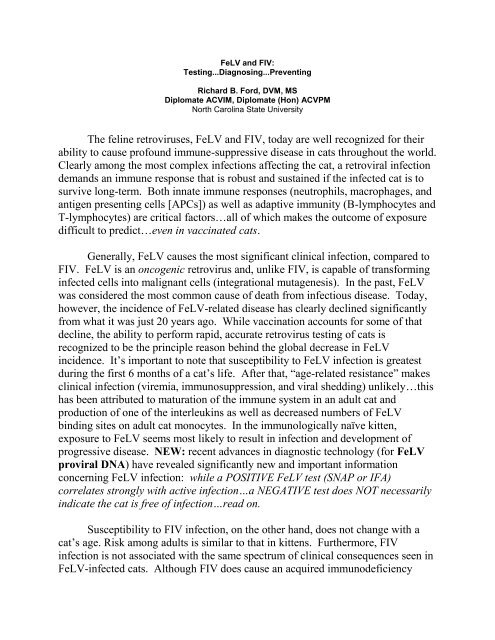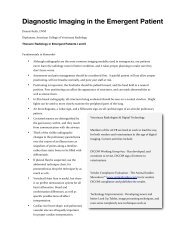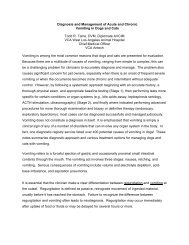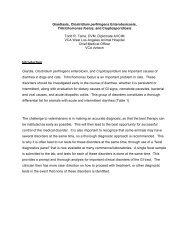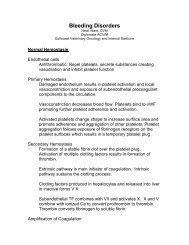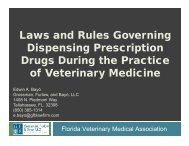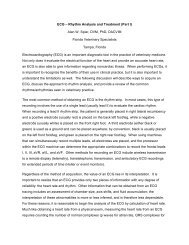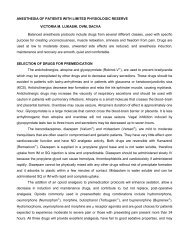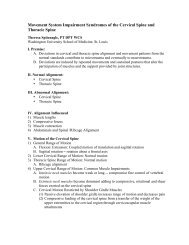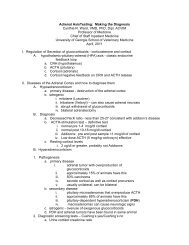Feline Leukemia Virus and Feline Immunodeficiency Virus ...
Feline Leukemia Virus and Feline Immunodeficiency Virus ...
Feline Leukemia Virus and Feline Immunodeficiency Virus ...
- No tags were found...
You also want an ePaper? Increase the reach of your titles
YUMPU automatically turns print PDFs into web optimized ePapers that Google loves.
complications linked to profound immune suppression (POSTIVE SNAP testresult).It’s the cat with the NEGATIVE (by IFA or ELISA) test result that’s at issuehere. With the ability to now look into cells, particularly bone marrowlymphocytes, it is apparent that cats having a NEGATIVE IFA or ELISA test may,in fact be POSITIVE. Based on the ability to detect FeLV proviral DNA ofchallenged, IFA <strong>and</strong> ELISA Negative cats, latent FeLV-infected cats can now beidentified…the so-called “hidden virus” residing in healthy appearing cats. And ithappens more often that we realized in the pre-Proviral DNA days.As will be described in the lecture, investigations into FeLV pathogenesisusing PCR technology have revealed better underst<strong>and</strong>ing on the consequences ofFeLV exposure. Generally (subtle variations occur), exposure takes on 1 of 4defined pathways:1) abortive infection; the immune response rapidly neutralizes virus <strong>and</strong>eliminates the infection (these appear to be rare; it’s quite unlikely you would everdetect this cat in practice);2) progressive infection; most often occurring in young cats/kittens, progressiveinfection is associated with persistent viremia (beyond 16 weeks), rapid onset ofclinical signs, immune suppression <strong>and</strong> frequently death (this is the sick cat with aPOSTIVE IFA or SNAP test result).3) regressive infection; this is now what appears to happen most often after FeLVexposure. Following a short period of viremia (generally 3 to 6 weeks but lessthan 16 weeks), <strong>Virus</strong> will ‘infect’ cells (especially bone marrowlymphocytes)…during that process, the viral RNA is released into the cytosol ofthe cell where the unique enzyme (characteristic of retroviruses), called ReverseTranscriptase, allows single-str<strong>and</strong>ed RNA to transform into complementaryDNA…this is proviral DNA. And…this is this the origin of the latently infectedcat. as proviral DNA then enters the nucleus of the cell <strong>and</strong> actually integrates intothe cat’s genome…where it can either sit…for years…or begin to produce newFeLV RNA (detectable by PCR as viral RNA). Conventional IFA <strong>and</strong> SNAP testsdo not detect proviral DNA or viral RNA. …<strong>and</strong>4) focal infection: although believed to be uncommon, FeLV may sequester,latently, within selected tissues/organs (eg, kidney, GI tract, bone marrow).Testing blood by IFA or SNAP test will be negative.
Saliva <strong>and</strong> tear tests should not be used for routine screening of individualcats. It should also be noted that neither maternal antibody nor prior FeLVvaccination interferes with the SNAP or IFA test results. Figure 1 will be usedduring the lecture to explain some of the fundamental issues behind interpretingtest results in cats at various stages in the course of FeLV infection as well asprovide an update on new information concerning pathogenesis of the infection<strong>and</strong> the meaning of a Negative test result.In contrast to FeLV, ELISA-based FIV tests are not considered to be reliablein kittens less than 6 months of age for at least 2 reasons:1) Since antibody response to FIV infection requires weeks or months to becomedetectable, a negative test result could occur in an exposed, infected kitten that hasnot seroconverted…2) also, uninfected kittens from FIV-infected queens may test positive as a resultof having acquired maternally-derived (colostrum) FIV antibody; detectable levelsof maternal FIV antibody can persist until around 6 months of age. NOTE:vaccinated queens that become seropositive are also able to transfer maternallyderived antibody to healthy, non-infected kittens resulting in a FALSE POSITIVEtest result.Among healthy cats with a positive ELISA test for either FeLV or FIV,follow-up testing is recommended. The clinician should repeat the ELISA test in1 to 3 months. As noted in Figure 1, re-testing 2-3 months following a POSTIVEtest result is justified in healthy cats considering the possibility that the infectionmay become regressive <strong>and</strong> the cat will subsequently develop a NEGATIVE testresult. (The consequences here are that the cat may still be infected…ie, withlatent proviral DNA hidden away somewhere).Among the retrovirologists in veterinary medicine, it is agreed today that theFeLV Ag test (NOTE: FeLV Ab titer is not a reliable diagnostic test), asperformed on the SNAP test, is a reliable (highly specific test) for infection. Whileat one time it was said that the indirect fluorescent antibody (IFA) test wasnecessary to “confirm” FeLV infection, that is no longer the case. Today, the IFAmerely corroborates positive results on the SNAP test.On the other h<strong>and</strong>, the SNAP Test for FIV antibody is not a confirmatorytest. Confirmation of infection is predicated on a positive Western blot assay. Incontrast to FeLV, the FIV-infected cat may live for years with its infection; early
detection <strong>and</strong> treatment of associated illness will enhance longevity <strong>and</strong> quality oflife.POINT OF FACT: any cat having an FeLV POSITIVE test (SNAP) resultis considered to be shedding virus, regardless of its health status. A cat that has anFeLV NEGATIVE test (SNAP) is not viremic <strong>and</strong> is not considered to be sheddingvirus. A cat having a “positive” test result for FIV, <strong>and</strong> confirmed by WesternBlot, still must be assessed for prior FIV vaccination history before it is possible toconfirm the diagnosis <strong>and</strong> establish risk. At this time, there is NO TEST that isconsidered to be consistently reliable in distinguishing infected from vaccinatedcats.Here’s the problem…all cats vaccinated with the current killed FIV vaccineare expected to develop FIV antibodies following administration of the first dose.Antibodies are known to persist for at least 1 year (much longer, actually).Vaccine-induced antibodies interfere with all commercially available FIV Ab testsin the North America, UK, <strong>and</strong> Europe.- SNAP® FeLV Antigen/FIV Antibody Combo (IDEXX Laboratories)- PetCHEK® FIV (IDEXX Laboratories)- All commercial Western Blot immunoassaysNOTE: Generally, a NEGATIVE FIV Antibody test result may still bereliably interpreted as negative for exposure <strong>and</strong> active infection.FeLV VaccinationToday, it does appear that the prevalence of FeLV within the domestic catpopulation has declined over the last decade. Two factors are most likely to haveplayed a major role in this decrease: vaccination <strong>and</strong> (especially) testing for FeLVantigen (<strong>and</strong> removal) of sick cats. However, results of a recent survey of >18,000cats in the US suggest that the prevalence of FeLV is still relatively high, around3% of all cats (feral <strong>and</strong> non-feral). Clearly the need for routine testing <strong>and</strong>vaccination of susceptible cats is justified.In accordance with AAFP <strong>Feline</strong> Vaccination Advisory Panel (2012), FeLVvaccination is highly recommended in kittens (because of the high degree of
susceptibility among kittens vs. adults). A reasonable vaccination schedule wouldbe:Two initial doses (required): eg, at 12 weeks <strong>and</strong> 16 weeks of ageOne dose (booster): 1 year later.Subsequent vaccination would depend on the assessment of risk for theindividual cat.> “High Risk” cats, for example, spend significant time outside,unsupervised: annual.> No to “Low Risk” cats, for example, indoor cats: no additionalvaccination required.Of the various FeLV vaccines available today, 2 are killed, whole-virus,vaccines (Merck <strong>and</strong> Boehringer-Ingelheim), 1 is a subunit vaccine (Pfizer), <strong>and</strong>,one is a recombinant (rFeLV) vaccine (Merial). All killed <strong>and</strong> sub-unit vaccinesdo contain an adjuvant <strong>and</strong> are licensed for parenteral administration as a 1.0 mLdose. A non-adjuvanted, recombinant FeLV( rFeLV) vaccine, licensed forparenteral administration, was introduced into the US market in January 2012 <strong>and</strong>replaces the transdermal (VetJet) vaccine. None of the licensed vaccines arebelieved to interfere with the either the IFA or ELISA (SNAP) test platforms. 2All FeLV vaccines, however, are NOT the same. The killed <strong>and</strong> subunitvaccines contain adjuvant 3 <strong>and</strong> require a 1.0 ml dose administered parenterally.The immunity conferred by these products centers on antibody production. Thenew, parenteral recombinant FeLV vaccine is a 1.0 mL dose of a non-adjuvanted,canarypox vectored vaccine administered subcutaneously. The recombinant FeLVvaccine immunizes by its ability to deliver 2 discrete FeLV genes that express 2immunogenic proteins: p27 (gag) <strong>and</strong> gp70 (env). Furthermore, the gp70 gene inthe vaccine has been genetically modified such that both innate (NK cells) <strong>and</strong>adaptive (CD8+ <strong>and</strong> T-cells) immune responses are enhanced. While none of theFeLV vaccines on the market have demonstrated “sterile” immunity, the rFeLVvaccine has been shown to enhance a cat’s cell mediated immune response tovirulent FeLV. (Cats vaccinated with the rFeLV vaccine containing modified gp70produce more INFgamma but less IL10, hence the enhanced CMI to FeLVfollowing vaccination.)2 FeLV-FIV Combo Test, Idexx Laboratories, Westbrook, ME (USA)3 Adjuvanted FeLV vaccines have been implicated as a cause of vaccine-associated fibrosarcoma in cats.
The canarypox virus is a widely recognized “vector-virus” for vaccineslicensed for horses, cats, dogs, <strong>and</strong> ferrets (a canarypox virus vectored vaccine iscurrently being studied in an HIV vaccine clinical trial in humans). The canarypoxvirus does not multiply (replicate) in the vaccinated animal (or person). Becausethe virus does not replicate, there is no risk of posta-vaccinal canarypox virusshedding.FIV VaccinationIn July 2002, a <strong>Feline</strong> <strong>Immunodeficiency</strong> <strong>Virus</strong> (FIV) vaccine wasintroduced -- (Fort Dodge, now Boehringer-Ingleheim). Infection is characterizedby a long latent period, infected cats gradually experience deterioration of immunefunction associated with declining numbers of T helper lymphocytes (CD4+).[REF: Levy, 2000] The consequences are manifest as a wide spectrum of vagueclinical features, none of which are diagnostically distinctive. Complicating theclinical picture is the fact that infected (presumably shedding) cats can appear to bequite healthy as reported by both the owner <strong>and</strong> subsequent to examination by aveterinarian.The principle serological test for FIV infection used throughout the world isthe determination of FIV antibody in serum. There is no reliable ‘antigen’ test. Theenzyme-linked immunosorbent assay (ELISA) <strong>and</strong> immunoblot (Western Blot)methods used to detect FIV antibody have become the mainstay for diagnosinginfected cats <strong>and</strong> conducting surveys among populations of cats at risk forinfection. Although PCR (polymerase chain reaction) assays are commerciallyavailable for both viral RNA <strong>and</strong> proviral DNA, independent studies have citedpoor sensitivity <strong>and</strong> specificity when using these tests.Epidemiological studies using FIV antibody <strong>and</strong> Western blot analysis haveprovided good evidence for horizontal transmission of FIV among cats <strong>and</strong> haveidentified adult male cats living outdoors as those at greatest risk of infection.Since the virus can be recovered from the saliva of infected cats, bite woundssustained during fighting are believed to be a principle means of virustransmission. On the other h<strong>and</strong>, casual contact among infected <strong>and</strong> non-infectedcats is an unlikely means of transmission. Although it appears possible that FIVcan be sexually transmitted, as the virus has been recovered from the semen ofinfected cats, this mode of transmission appears to be uncommon in nature.Likewise, transmission from infected queen to fetus (vertical transmission) ispossible, but rare. On the other h<strong>and</strong>, it is more likely that infected queens will
transfer FIV antibody, rather than virus, via colostrum to nursing kittens. Sincematernal FIV antibody may persist in kittens for several months, it is customary todisregard a “positive” FIV antibody test result in healthy kittens under 6 months ofage. Follow-up testing is indicated once a cat reaches maturity.The introduction <strong>and</strong> use of the killed FIV vaccine substantially changed theapproach clinicians use to assess potentially infected cats. Of particular importanceis the fact vaccination is known to be associated with development of FIV antibodythat interferes with all FIV tests on the market today. In addition, it has recentlybeen demonstrated that a vaccinated, seropositive queen will pass antibody tokittens (presumably through colostrum). FIV testing of kittens that nursed fromFIV seropositive cats will cause a false positive test result. Until an alternative,reliable, <strong>and</strong> accessible laboratory test for FIV infection is made available, or analternative (recombinant) vaccine is introduced, veterinarians have lost the abilityto distinguish between a vaccinated cat <strong>and</strong> an infected cat.Administration of the FIV vaccine should be accompanied by some meansof identifying the cat (tattoo or microchip) in the event the cat becomes lost.Treatment of FeLV/FIVOver the past decade, a number of studies have been published that address awide variety of treatment modalities for retrovirus-infected cats targeting cancer(FeLV-related), hematologic disorders (anemia, leucopenia), antiviralchemotherapy, immunomodulator therapy, <strong>and</strong> antibody therapy. 6 While it ispossible to manage lymphoid tumors <strong>and</strong> hematologic disorders, the outcomes areexpected to be transient as complications associated with the persistently infected<strong>and</strong> viremic cats unfold. Despites several attempts to treat the viremia, nomodality has demonstrated sustained beneficial effects. Reference 6 (below)details several options for the treatment of FeLV <strong>and</strong> FIV.PrognosisOverall, when supportive care is provided, FeLV-infected, viremic cats havea poorer prognosis than FIV-infected cats. That said, it is not unreasonable forsome clientele to maintain FeLV + cats (several in the same household) <strong>and</strong> reportlong-term survivals despite evidence of active viremia <strong>and</strong> shedding. A positivetest (IFA or ELISA) for FeLV is not necessarily associated with impending deathor poor quality life.
Additional Reading1. Levy JK: CVT Update: feline immunodeficiency virus In, JD Bonagura (ed): CurrentVeterinary Therapy XIII. WB Saunders, Philadephia. pp. 284-288, 2000.2. Levy JK, Crawford C, Hartmann K, et al: 2008 American Association of <strong>Feline</strong> Practitioners’feline retrovirus management guidelines. J <strong>Feline</strong> Med <strong>and</strong> Surg. (2008) 10, 300-316. (alsoavailable on-line at the AAFP official website: www.catvets.com)3. Leutenegger CM, Klein D, Hofmann-Lehmann R, et al: Rapid feline immunodeficiency virusprovirus quantitiation by polymerase chain reaction using the TaqMan® florigenic real-timedetection system. Journal of Virological Methods. 78:105-116, 1999.4. Zenger E: FIP, FeLV, <strong>and</strong> FIV: making a diagnosis. <strong>Feline</strong> Pract. 28:16-18, 2000.5.Hartmann K: <strong>Feline</strong> immunodeficiency virus infection-an overview. Vet J. 155:123-157, 1998.6. Hartmann K. <strong>Feline</strong> leukemia infection. Chapt. 11 <strong>and</strong> (Sellon <strong>and</strong> Haartmann) Chapt.12 InCE Greene (ed). Infectious Diseases of the Dog <strong>and</strong> Cat.4 th Ed. Saunders-Elsevier, St Louis.pp. 108-136 <strong>and</strong> 136-149, 2012. (comprehensive, in-depth presentation of FeLV <strong>and</strong> FIVinfection in cats).7. Hartmann K. <strong>Feline</strong> <strong>Leukemia</strong> <strong>Virus</strong> <strong>and</strong> <strong>Feline</strong> <strong>Immunodeficiency</strong> <strong>Virus</strong>. Chapt. 281 inCurrent Veterinary Therapy XIV. pp. 1278-1283, 2009.Updated February 2012Figure 1: FeLV Testing in the Clinical SettingORONASALINFECTIONusually viasalivaInfection is ‘ABORTED’.NO VIREMIA(uncommon)monocytestissueViremic Phase…typically lasts 3 to 6 weeks; notmore than 16 weeks.> Local lymphoid tissue> Circulating> Systemic lymphoid> Bone marrow
Infection is‘REGRESSIVE’(Common)Viremic PhaseIF extended beyond16 weeksPersistent Viremia is Expected<strong>Virus</strong> is contained inBone Marrowlymphocytes(Latent Infection)REACTIVATION of VIREMIAis possible…risk may decline with age.Infection is‘PROGRESSIVE’(Less Common)Well CatNot so ‘well’ Cat


